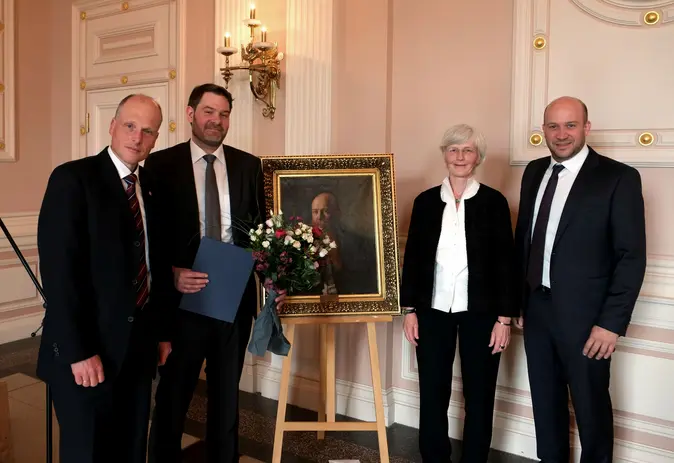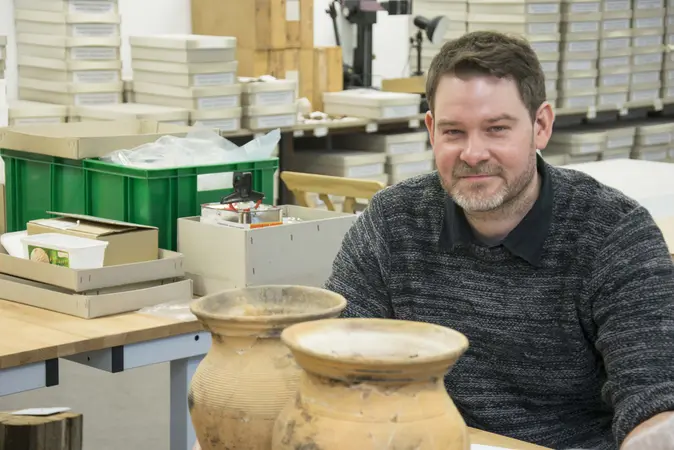Udo Recker (left), Franziska Lang and State Secretary Ingmar Jung congratulate Eike Henning Michl (2nd from left) on the 2017 Eduard-Anthes-Preis.
Eike Henning Michl’s excavations on the Kapellberg uncovered numerous artifacts, including shards from these ceramic vessels.
Distinguished Dissertation
On Friday 21 April, Dr. Eike Henning Michl was awarded the prestigious Eduard-Anthes-Preis for his dissertation in the field of medieval and post medieval archaeology at the University of Bamberg. At a ceremony in the Haus der Geschichte in Darmstadt, State Secretary Ingmar Jung, the Hessian state archaeologist Dr. Udo Recker and the chairwoman of the Verein von Altertumsfreunden im Regierungsbezirk Darmstadt e.V. (society of the friends of antiquity, Darmstadt), Prof. Dr. Franziska Lang presented Michl with the award. Michl’s dissertation, “Castellum, Curia, Palatium?! The medieval settlement history of a Main-Franconian centre on the Kapellberg near Gerolzhofen” is the result of many years’ work. “In total, I worked on this project for about six years, and so I’m naturally overjoyed at both the award and the appreciation of my research findings,” says Michl.
Dissertation advisor Prof. Dr. Ingolf Ericsson explained the distinctive features of the award-winning work in his laudatory address, saying, “The pleasantly source-critical and interdisciplinary handling of Eike Henning Michl’s dissertation, with its thoroughly unanticipated yet compelling findings on the emergence and development of a historic site that was as prominent in medieval times as it is obscure today, is evidence that the author is both a highly qualified and exceedingly accomplished medieval and post medieval archaeologist. Moreover, the work bears witness to his exceptional aptitude for the handling of historic architectural and, particularly, literary sources.”
The archaeological excavations near the Lower Franconian city of Gerolzhofen were conducted between 2007 and 2010 by a team of approximately 60 students and permanent staff. A look at the findings shows that the project was unquestionably successful: the archaeological discoveries made on the Kapellberg have established that the site was a centre of power for local elites from the 8th to the 15th centuries – a fact that was previously completely unknown. Beginning as an early medieval castle complex or “castellum” in the 8th through the 10th centuries, it developed into an economic court – a “curia” – of the Würzburg bishops in the 11th century and was ultimately elevated to a “palatium” or administrative centre of the bishopric in the 14th century. Of these residence-like properties, only five were under the influence of the church in Würzburg.
Eike Henning Michl’s dissertation had already been recognised by the University of Bamberg with two awards in 2016: the Hans-Löwel-Wissenschaftspreis and the Otto-Meyer-und-Elisabeth-Roth-Promotionspreis. And the crowning achievement is now the Eduard-Anthes-Preis. Since 1985, the € 7,500 award has been given to honour young academics who have produced outstanding dissertations on the archaeology of the Central German Uplands. “This is Germany’s most highly endowed award for archaeological dissertations. And it’s also notable because it’s awarded by the Verein von Altertumsfreunden in conjunction with both the Hessian State Ministry for Higher Education, Research and the Arts, and the state archaeological department hessenARCHÄOLOGIE,” explains Prof. Franziska Lang.
The Eduard-Anthes-Preis has been awarded for the 17th time – and for the first time to a scholar from the University of Bamberg’s department of Medieval and Post Medieval Archaeology. It was here that Michl completed his Magister degree in 2007, and he has been contributing to the department as a research assistant ever since. In addition to the Kapellberg project, he has also headed activities that include an excavation of the east chancel in the Bamberg cathedral and research on a Lower Franconian village that was destroyed and abandoned during the Thirty Years’ War. On 30 June, he will complete the latter project with the publication of a book on a Northern Bavarian village between the 14th and 17th centuries.

